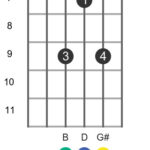“Norwegian Wood (This Bird Has Flown)” by The Beatles is a classic song loved by guitarists for its unique sound and relatively simple chord structure. This guide will break down the guitar chords for “Norwegian Wood”, making it easy for you to learn and play this iconic tune. Whether you’re a beginner guitarist or looking to expand your repertoire, mastering the chords to “Norwegian Wood” is a rewarding experience.
Understanding the Chords in Norwegian Wood
The song primarily uses a set of basic chords, making it accessible for guitarists of various skill levels. Here are the chords you’ll need to know:
- D
- C
- G
- Dm (D minor)
- Em (E minor)
- A
These chords are fundamental in guitar playing, and learning them through a song like “Norwegian Wood” is an excellent way to solidify your chord vocabulary. The song’s progression relies on the interplay between major and minor chords, creating its distinctive melancholic and folk-inspired sound.
“Norwegian Wood” Chord Progression Breakdown
Here’s a section-by-section breakdown of the chord progression for “Norwegian Wood”. Follow along and practice each part to learn the song structure.
Intro:
D D |D C G| D (x2)The intro establishes the main key and sets a gentle, folk-like mood. The progression moves smoothly between D, C, and G chords, creating a simple yet captivating harmonic foundation.
Verse 1:
D D D D D |D C G |D D
I once had a girl, or should I say, she once had me.
D D D D D |D C G |D D
She showed me her room, isn’t good, Norwegian wood.
Dm Dm Dm Dm G G G G
She asked me to stay and she told me to sit anywhere.
Dm Dm Dm Dm Em Em A A
So I looked around and I noticed there wasn’t a chair.The verses continue with the D, C, G progression, grounding the song in its familiar tonality. The introduction of Dm, G, Em, and A chords in the latter part of the verse adds a touch of harmonic interest and prepares for the next section.
Verse 2:
D D D D D |D C G |D D
I sat on a rug biding my time, drinking her wine.
D D D D D |D C G |D D
We talked until two and then she said, “it’s time for bed.”Verse 2 mirrors the chord progression of Verse 1, maintaining the song’s consistent and recognizable structure.
Interlude:
D D D D D |D C G| D D D D D D D |D C G| D DThe interlude provides a instrumental break, reiterating the foundational D, C, G progression and acting as a bridge between verses.
Verse 3:
Dm Dm Dm Dm G G G G
She told me she worked in the morning and started to laugh.
Dm Dm Dm Dm Em Em A A
I told her I didn’t and crawled off to sleep in the bath.
D D D D D |D C G |D D
And when I awoke I was alone, this bird had flown.
D D D D D |D C G |D D
So I lit a fire, isn’t it good, Norwegian wood.Verse 3 revisits the chord patterns from the previous verses, with the Dm, G, Em, A sequence returning before resolving back to the D, C, G progression for the final lines.
Outro:
D D D D D |D C G| DThe outro is a shortened version of the intro, bringing the song to a gentle close with the familiar D, C, G sequence.
Tips for Playing “Norwegian Wood” on Guitar
- Strumming Pattern: A simple down-down-up-down-up strumming pattern often works well for “Norwegian Wood,” capturing its folk-like rhythm. Experiment to find what feels and sounds best to you.
- Fingerstyle Approach: “Norwegian Wood” is famously played with a fingerstyle approach in the original recording, incorporating a sitar-like sound. While the chords are the same, exploring fingerstyle can add a new dimension to your playing. Try plucking the root note of each chord on the downbeat and then strumming or arpeggiating the remaining strings.
- Chord Transitions: Focus on smooth transitions between chords, especially between D and C, and C and G. Practice these transitions slowly at first, gradually increasing your speed as you become more comfortable.
- Listen to the Original: Listening carefully to The Beatles’ recording of “Norwegian Wood” is crucial. Pay attention to the rhythm, tempo, and overall feel of the song to guide your playing.
- Capo: While not strictly necessary for these chords, some guitarists prefer to use a capo to match the key of the original recording more closely. Experiment with a capo on the 2nd fret if you wish to play along with the original track.
- Practice Regularly: Consistent practice is key to mastering any song. Dedicate some time each day to practice the chords and chord progression for “Norwegian Wood,” and you’ll be playing it smoothly in no time.
Conclusion
“Norwegian Wood” is a fantastic song for guitarists to learn. Its memorable melody and straightforward chord progression make it both enjoyable to play and a great addition to your guitar songbook. By learning these “Norwegian Wood Guitar Chords” and practicing the song structure, you’ll be able to play this Beatles classic and impress your friends with your growing guitar skills. Happy playing!


